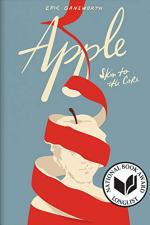|
This section contains 734 words (approx. 2 pages at 400 words per page) |

|
Apple: Skin to the Core Summary & Study Guide Description
Apple: Skin to the Core Summary & Study Guide includes comprehensive information and analysis to help you understand the book. This study guide contains the following sections:
This detailed literature summary also contains Topics for Discussion on Apple: Skin to the Core by Eric Gansworth.
The following version of this book was used to create this study guide: Gansworth, Eric. Apple: Skin to the Core. New York: Levine Querido, 2020.
Apple: Skin to the Core is a memoir written in verse. In Part I, “Apple Records,” Gansworth explains that three of his four grandparents were sent to Indian boarding schools as children. The most well-known of these schools was the Carlisle Indian Industrial School in Pennsylvania. The mission of the schools was to forcibly assimilate Indian children so they would be less likely to return to the reservation and less likely to pass their cultural traditions down to the next generations. Gansworth notes that the term “Apple” is commonly used to describe an American Indian who is very assimilated into white society—someone who is “Red on the outside, white on the inside” (4). His grandmother on his mother's side, Big Umma, refused to let Gansworth's mother learn beadwork at school because she had internalized the belief that her culture was inferior.
In Part II, “The Red Album,” the author recounts significant events from his childhood and adolescence. He grew up part Onondaga, part Tuscarora on the Tuscarora reservation in upstate New York. He lived on a street called Dog Street in a small, poorly heated house where he often did not have enough to eat. He was the youngest of seven children and partly raised by his older siblings because his mother worked full time and his father was not present. Gansworth often felt alienated from his peers because he was more interested in books and superheroes than sports. He developed a fascination with the Beatles and David Bowie because he related to their music. There were few Indian characters in the books he read, and when they did appear, they were often based on stereotypes. He attended a predominantly Indian elementary school but then moved on to a predominantly white junior high and high school. He watched each of his siblings grow up and move out of the house, though sometimes they returned. He began working at age 14 on a grape farm and later worked in a garage and a junkyard, always turning over some of his pay to his mother for household expenses. All the while, he worked on his drawing skills, hoping to one day establish a better life for himself by working in the arts. His friend Jaboozie gave him a book about cult classic films and encouraged him to go to college.
The poems in Part III, “Dog Street,” are titled after the tracks on the Beatles' album Abbey Road. Gansworth graduated high school and worried he would be working at the junkyard forever as his peers headed off to college. However, one day someone left a pamphlet advertising the local community college at his house and he decided to enroll in a medical program. He moved out of his family home and into an apartment off the reservation. As he attended college, he continued to fantasize about making art and/or writing for a living.
In Part IV, “Get Back,” Gansworth recalls attending another college, pursuing literature. He had a friend named Wendy, with whom he shared intimate details about his life. He told her that he is gay, but he was too afraid of being rejected to tell his other loved ones. He fell in love with a man he refers to as “Bumblebee” (250). The man is also an artist and an American Indian. As he matured into adulthood, Gansworth continued to return to the reservation to take part in cultural traditions there. He learned these traditions and taught them to others, hoping to preserve the Tuscarora culture for future generations. The house he grew up in burned down and his mother moved in with one of his siblings. Most of their possessions, including family photographs, were destroyed. When his nephew got married, his bride's sister made Gansworth a ribbon shirt in exchange for his work creating the wedding invitations. His mother died at the age of 81 after suffering a stroke. In the final poem, Gansworth recalls receiving a photograph from his sister. It was an aerial view of their family home, taken at some point for their grandmother. He imagines all of the earlier generations of his family seeing that aerial view as they ascended to the afterlife, and wonders if he will see it when he dies as well.
Read more from the Study Guide
|
This section contains 734 words (approx. 2 pages at 400 words per page) |

|



